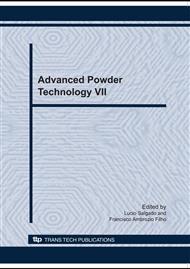p.936
p.943
p.948
p.954
p.959
p.965
p.971
p.977
p.983
The Effect of Hydrothermal Treatment on Samaria and Gadolinia Doped Ceria Powders Synthesized by Coprecipitation
Abstract:
One of the main applications of ceria-based (CeO2) ceramics is the manufacturing of Intermediate Temperature Solid Oxide Fuel Cells electrolytes. In order to improve ionic conductivity and densification of these materials various powder synthesis routes have been studied. In this work powders with composition Ce0.8(SmGd)0.2O1.9 have been synthesized by coprecipitation and hydrothermal treatment. A concentrate of rare earths containing 90wt% of CeO2 and other containing 51% of Sm2O3 and 30% of Gd2O3, both prepared from monazite processing, were used as precursor materials. The powders were characterized by X-ray diffraction, scanning and transmission electron microscopy, agglomerate size distribution by laser scattering and specific surface area by gas adsorption. Ceramic sinterability was evaluated by dilatometry and density measurements by Archimedes method. High specific surface area powders (~100m2/g) and cubic fluorite structure were obtained after hydrothermal treatment around 200°C. Ceramic densification was improved when compared to the one prepared from powders calcined at 800°C.
Info:
Periodical:
Pages:
959-964
Citation:
Online since:
October 2010
Keywords:
Price:
Сopyright:
© 2010 Trans Tech Publications Ltd. All Rights Reserved
Share:
Citation:


